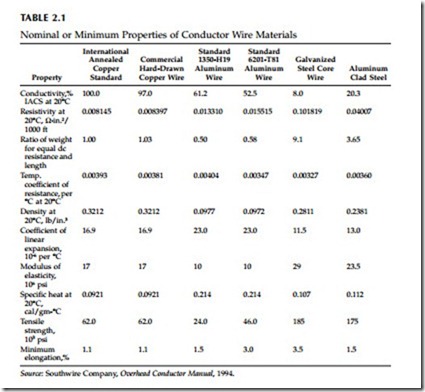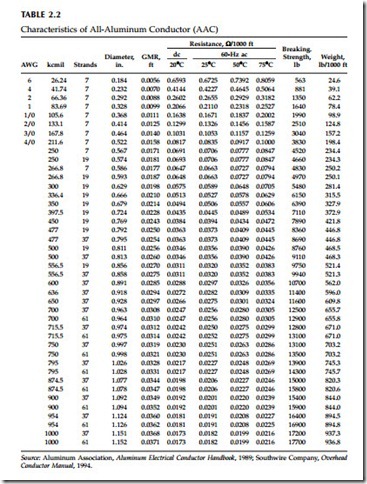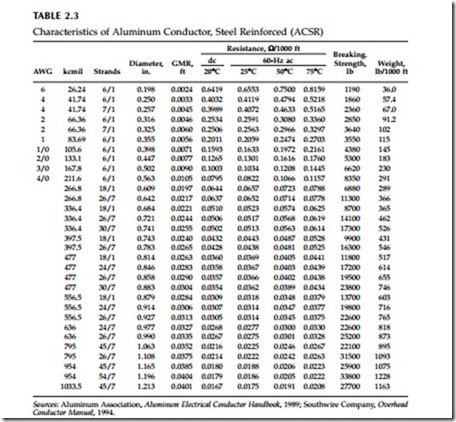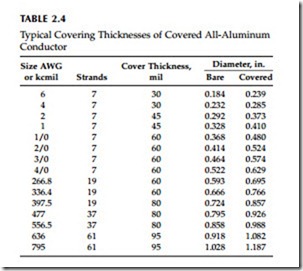Conductor Data
A wire is metal drawn or rolled to long lengths, normally understood to be a solid wire. Wires may or may not be insulated. A conductor is one or more wires suitable for carrying electric current. Often the term wire is used to mean conductor. Table 2.1 shows some characteristics of common conductor metals. Most conductors are either aluminum or copper. Utilities use aluminum for almost all new overhead installations. Aluminum is lighter and less expensive for a given current-carrying capability. Copper was installed more in the past, so significant lengths of copper are still in service on overhead circuits.
Aluminum for power conductors is alloy 1350, which is 99.5% pure and has a minimum conductivity of 61.0% IACS [for more complete character-istics, see the Aluminum Electrical Conductor Handbook (Aluminum Association, 1989)]. Pure aluminum melts at 660°C. Aluminum starts to anneal
(soften and lose strength) above 100°C. It has good corrosion resistance; when exposed to the atmosphere, aluminum oxidizes, and this thin, invisible film of aluminum oxide protects against most chemicals, weathering condi- tions, and even acids. Aluminum can corrode quickly through electrical contact with copper or steel. This galvanic corrosion (dissimilar metals corrosion) accelerates in the presence of salts.
Several variations of aluminum conductors are available:
• AAC — all-aluminum conductor — Aluminum grade 1350-H19 AAC has the highest conductivity-to-weight ratio of all overhead conduc- tors. See Table 2.2 for characteristics.
• ACSR — aluminum conductor, steel reinforced — Because of its high mechanical strength-to-weight ratio, ACSR has equivalent or higher ampacity for the same size conductor (the kcmil size designation is determined by the cross-sectional area of the aluminum; the steel is neglected). The steel adds extra weight, normally 11 to 18% of the weight of the conductor. Several different strandings are avail- able to provide different strength levels. Common distribution sizes of ACSR have twice the breaking strength of AAC. High strength means the conductor can withstand higher ice and wind loads. Also, trees are less likely to break this conductor. See Table 2.3 for characteristics.
• AAAC — all-aluminum alloy conductor — This alloy of aluminum, the 6201-T81 alloy, has high strength and equivalent ampacities of AAC or ACSR. AAAC finds good use in coastal areas where use of ACSR is prohibited because of excessive corrosion.
• ACAR — aluminum conductor, alloy reinforced — Strands of aluminum 6201-T81 alloy are used along with standard 1350 aluminum. The alloy strands increase the strength of the conductor. The strands of both are the same diameter, so they can be arranged in a variety of configurations.
For most urban and suburban applications, AAC has sufficient strength and has good thermal characteristics for a given weight. In rural areas, utilities can use smaller conductors and longer pole spans, so ACSR or another of the higher-strength conductors is more appropriate.
Copper has very low resistivity and is widely used as a power conductor, although use as an overhead conductor has become rare because copper is heavier and more expensive than aluminum. It has significantly lower resis- tance than aluminum by volume — a copper conductor has equivalent ampacity (resistance) of an aluminum conductor that is two AWG sizes larger. Copper has very good resistance to corrosion. It melts at 1083°C, starts to anneal at about 100°C, and anneals most rapidly between 200 and 325°C (this range depends on the presence of impurities and amount of hardening).
When copper anneals, it softens and loses tensile strength.
Different sizes of conductors are specified with gage numbers or area in circular mils. Smaller wires are normally referred to using the American wire gage (AWG) system. The gage is a numbering scheme that progresses geo- metrically. A number 36 solid wire has a defined diameter of 0.005 in.
cm), and the largest size, a number 0000 (referred to as 4/0 and pronounced “four-ought”) solid wire has a 0.46-in. (1.17-cm) diameter. The larger gage sizes in sequence of increasing conductor size are: 4, 3, 2, 1, 0 (1/0), 00 (2/ 0), 000 (3/0), 0000 (4/0). Going to the next bigger size (smaller gage number) increases the diameter by 1.1229. Some other useful rules are:
• An increase of three gage sizes doubles the area and weight and halves the dc resistance.
• An increase of six gage sizes doubles the diameter.
Larger conductors are specified in circular mils of cross-sectional area. One circular mil is the area of a circle with a diameter of one mil (one mil is one- thousandth of an inch). Conductor sizes are often given in kcmil, thousands
of circular mils. In the past, the abbreviation MCM was used, which also means thousands of circular mils (M is thousands, not mega, in this case). By definition, a solid 1000-kcmil wire has a diameter of 1 in. The diameter
of a solid wire in mils is related to the area in circular mils by d = A .
Outside of America, most conductors are specified in mm2. Some useful
conversion relationships are:
1 kcmil = 1000 cmil = 785.4 ´ 10–6 in2 = 0.5067 mm2
Stranded conductors increase flexibility. A two-layer arrangement has seven wires; a three-layer arrangement has 19 wires, and a four-layer arrangement has 37 wires. The cross-sectional area of a stranded conductor is the cross-sectional area of the metal, so a stranded conductor has a larger diameter than a solid conductor of the same area.
The area of an ACSR conductor is defined by the area of the aluminum in the conductor.
Utilities with heavy tree cover often use covered conductors — conductors with a thin insulation covering. The covering is not rated for full conductor line-to-ground voltage, but it is thick enough to reduce the chance of flash- over when a tree branch falls between conductors. Covered conductor is also called tree wire or weatherproof wire. Tree wire also helps with animal faults and allows utilities to use armless or candlestick designs or other tight configurations. Tree wire is available with a variety of covering types. The insulation materials polyethylene, XLPE, and EPR are common. Insulation thicknesses typically range from 30 to 150 mils (1 mil = 0.001 in. = 0.00254 cm); see Table 2.4 for typical thicknesses. From a design and operating viewpoint, covered conductors must be treated as bare conductors according to the National Electrical Safety Code (NESC) (IEEE C2-2000), with the only difference that tighter conductor spacings are allowed. It is also used in Australia to reduce the threat of bush fires (Barber, 1999).
While covered wire helps with trees, it has some drawbacks compared with bare conductors. Covered wire is much more susceptible to burndowns caused by fault arcs. Covered-wire systems increase the installed cost some- what. Covered conductors are heavier and have a larger diameter, so the ice and wind loading is higher than a comparable bare conductor. The covering may be susceptible to degradation due to ultraviolet radiation, tracking, and mechanical effects that cause cracking. Covered conductors are more sus- ceptible to corrosion, primarily from water. If water penetrates the covering, it settles at the low points and causes corrosion (it cannot evaporate). On bare conductors, corrosion is rare; rain washes bare conductors periodically, and evaporation takes care of moisture. The Australian experience has been that complete corrosion can occur with covered wires in 15 to 20 years of operation (Barber, 1999). Water enters the conductor at pinholes caused by lightning strikes, at cover damage caused by abrasion or erosion, and at holes pierced by connectors. Temperature changes then cause water to be
Spacer cables and aerial cables are also alternatives that perform well in treed areas. Spacer cables are a bundled configuration using a messenger wire holding up three phase wires that use covered wire. Because the spacer cable has significantly smaller spacings than normal overhead constructions, its reactive impedance is smaller.
Guy wires, messenger wires, and other wires that require mechanical strength but not current-carrying capability are often made of steel. Steel has high strength (see Table 2.5). Steel corrodes quickly, so most applications use galvanized steel to slow down the corrosion. Because steel is a magnetic material, steel conductors also suffer hysteresis losses. Steel conductors have much higher resistances than copper or aluminum. For some applications requiring strength and conductivity, steel wires coated with copper or alu- minum are available. A copperweld conductor has copper-coated steel strands, and an alumoweld conductor aluminum-coated steel strands. Both have better corrosion protection than galvanized steel.



